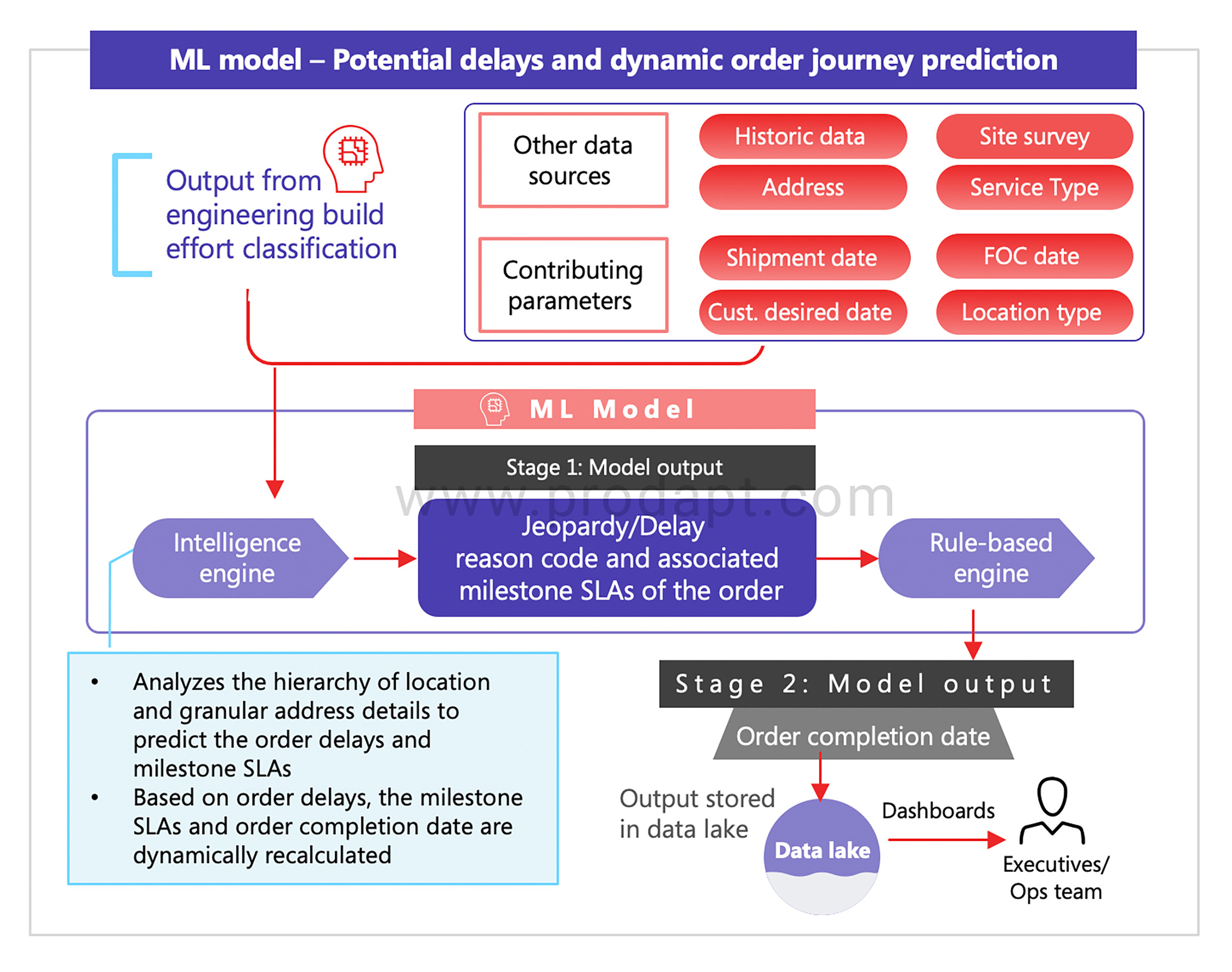Service delivery operations are vital for the success of Digital Service Providers (DSPs). However, most DSPs struggle with the conventional service delivery process leading to high customer churn and reduced NPS. Based on the engagements with various DSPs, we identified the common challenges that the conventional enterprise service delivery process faces as below:
- Siloed systems and multiple manual hand-offs
- Dependency on the process and SLAs of third parties for order completion
- Handling the order delays and providing efficient service delivery according to the customer commit date
- Lack of mechanisms to track the milestones and complete the service delivery flow in real-time
These challenges lead to a 50-60% reduced number of order completions per month, thus resulting in dissatisfied customers. Hence, DSPs need to embrace AI/ML techniques in their enterprise service delivery operations to reduce cycle time by 30% and increase the order completion rate by 2x. Implementing an ML model right at the beginning of the service delivery process assists the DSPs to left shift the operations and gain control of the entire order journey.
Fig 1. AI/ML-powered predictive service delivery operations
In this article, we have detailed a four-step process that the DSPs can adopt to incorporate predictive capabilities and accelerate their service delivery process.
Implementing predictive capabilities for accelerated service delivery
- Predict and classify the engineering build effort using an ML model
Identifying the build effort type is primary in predicting the accurate order completion date and accelerating the service delivery process. Once the order flows in, classify the required engineering build effort into one of the following- no build, small, complex, and special, based on the historic site survey data. This can be achieved by using Gradient Boosting Classifier and NLP packages like Fuzzy and Genism. Based on the predicted build effort type, the various alerts/reports can be sent to the operations team to accelerate the process and complete the orders within the customer commit date.
Recommendations
- Implement a scorecard to compare the build type predicted by an ML model vs assessment by field engineer for data validation and fine-tuning of the model
- Implement an automated mechanism to identify discrepancies in the site survey data and send periodic reports to the operations team. This helps in efficient build type classification and improved ML model accuracy
- Predict the potential delays and order journey milestones ahead of time
Once the engineering build effort type is predicted, it can be fed to the ML model along with other order details like address and service type. The ML model can use these inputs to analyze the granular address details and forecast the order delays. The milestone SLAs and order completion date can be dynamically recalculated based on the order delays.
Fig 2. ML model for prediction of order delays and order journey milestones
Recommendations
- In a typical service delivery process, around 30-40% of the new orders do not have an actionable delay reason associated with them. Implement a ‘Smart Fix’ tool that fills the missing records by extracting and processing data from multiple sources. Feed these records to the model for improved accuracy.
- Analyse the fallout scenarios to identify and automate the repetitive tasks in each milestone.
- Analyze the customer emotions using a Deep-Learning Framework to reprioritize the orders in real-time
While the DSPs find ways to provide efficient service delivery by dynamically predicting the milestone SLAs of the order journey, understanding the customer emotions, and prioritizing the orders also plays a vital role in reducing customer churn. Since the customer cases can be from a variety of sources that vary in format, collate them in a common database and feed them to the ML model. Schedule the model to work on the customer cases periodically, extract the latest cases and predict the sentiment. Based on the predicted emotions, the high-priority unsatisfied customer reports can be sent for the operations team to re-prioritize and accelerate the orders.
Recommendations
- Leverage sentence tone analyzer and smart intent detection along with custom ML algorithms for easy scanning of huge customer conversations from webchat and email
- Generate timely reports with dynamic report template using Qlik Nprinting
- Develop a digital dashboard for end-to-end visibility of the orders
Build a digital experience dashboard such that it provides the ability to track all in-flight orders and focus on numerous KPIs. It is possible to develop unique reports on the milestone buckets to provide real-time and in-depth visibility into the key steps along the order journey. The end-to-end dashboard boosts the entire service delivery process and reduces the DSPs’ effort by 80%.
In Conclusion
By implementing predictive capabilities in enterprise service delivery operations, as explained in this article, a leading DSP in North America gained control of the entire order journey. They also experienced the following benefits:
- Increased order completion rate by 2x
- Accelerated orders by 30%-40% due to order prioritization
- Reduced the order interval time by 30%
- Improvement in NPS
I thank Senthil Murugan – Sr. Technical Lead, Mohana Priya – Software Engineer, and Priyankaa A from Strategic Insights for their contributions in shaping up this article.
By Boominathan Shanmugam

Boominathan is a hands-on technology leader with 15+ years of consulting experience. He is passionate about enabling organizations to extract the full potential of their data assets and make data-driven business decisions, be it strategic or tactical. Boominathan has immense practical knowledge of architecting NextGen products and effectively implementing solutions using AI/ML, Cloud, Edge, and Blockchain. He has successfully defined and delivered digital transformation programs, partnering with C-level leadership for globally leading telcos/digital service providers.
Boominathan is a digital transformation leader at Prodapt, the leading consulting, technology, and managed services provider to the Connectedness vertical. Prodapt’s customers range from telecom operators, digital / multi-service providers (D/MSPs), technology and digital platform companies in the business of Connectedness. Prodapt builds, integrates, and operates solutions enabling DSPs on their transformation journey at several layers, including cloud, customer experience, business outcome-focused initiatives, CapEx, and OpEx optimization programs.


